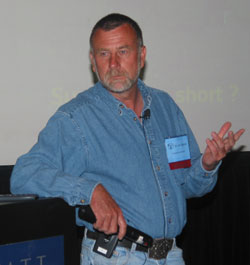Managing Tall Fescue Pastures
While tall fescue is considered an aggressive specie that crowds out other plants, Missouri-based grazing lands consultant Jim Gerrish told attendees of the 35th Annual Beef Improvement Federation (BIF) Meeting that pasture management can keep the endophyte-infected fescue toxicity problem in check.
 Jim Gerrish, GrazingLand Consultant
Jim Gerrish, GrazingLand Consultant
|
According to Gerrish, fescue is more or less toxic, depending on the plant’s stage of development. While the toxin is always present in the plant, it is far more concentrated in the seed than in the leaves. Mechanically clipping pastures to prevent formation of seedheads can reduce toxin ingestion by cattle, but the same thing may be achieved through planned rotational grazing. Keeping fescue in a vegetative state results in reduced toxicity.
Typically, fescue is most toxic during late spring and early summer, so avoidance of infected fescue pastures during May and June can be an effective strategy. Gerrish said development of alternative pastures using warm-season grasses will fit complementary grazing systems developed for the Midwest, while Bermuda grass and other species may be better suited to operations located farther south. Summer annuals, such as crabgrass, millets and Sudan grass make satisfactory complimentary forages. Summer annuals may also be used to provide alternative grazing when infected fescue pastures are being renovated.
The key to managing fescue, Gerrish stressed, is remembering that the growing season isn’t necessarily the same as the grazing season. Even endophyte-infected fescue pastures offer options for winter grazing, particularly with fall-calving cow herds.
“One of the quickest ways to overcome fescue toxicity problems in a breeding herd is to switch to fall-calving,” Gerrish said.
Many producers call fall calving systems too expensive because the cow’s greatest nutritional needs, during peak lactation, must be met with harvested forage or concentrates. However, Gerrish considers tall fescue to be the perennial grass best adapted to fall stockpiling for winter grazing. It grows rapidly in late summer and fall, increasing energy content in response to shorter day length and cooler nights, and it withstands freeze damage better than other cool-season species.
“It provides the best opportunity for a low-cost winter grazing system that allows us to effectively breed cows at a time of year when fescue toxicity is a minimal problem,” Gerrish added.
In addition to pasture management, Gerrish says selection for tolerance to fescue is important. While some animals become debilitated on infected-fescue pastures, some herdmates often show very little effect. Over time, culling of the most susceptible animals, while selecting replacements from those least affected, will increase the fescue tolerance of the herd.
Because of its many desirable attributes as a pasture species, Gerrish warned producers against trying to eliminate tall fescue, and urges them to use it to best advantage.
The BIF meeting was held May 28-31, 2003, in Lexington, Ky. To access the audio to Gerrish’s presentation or the proceedings paper, visit the newsroom.

